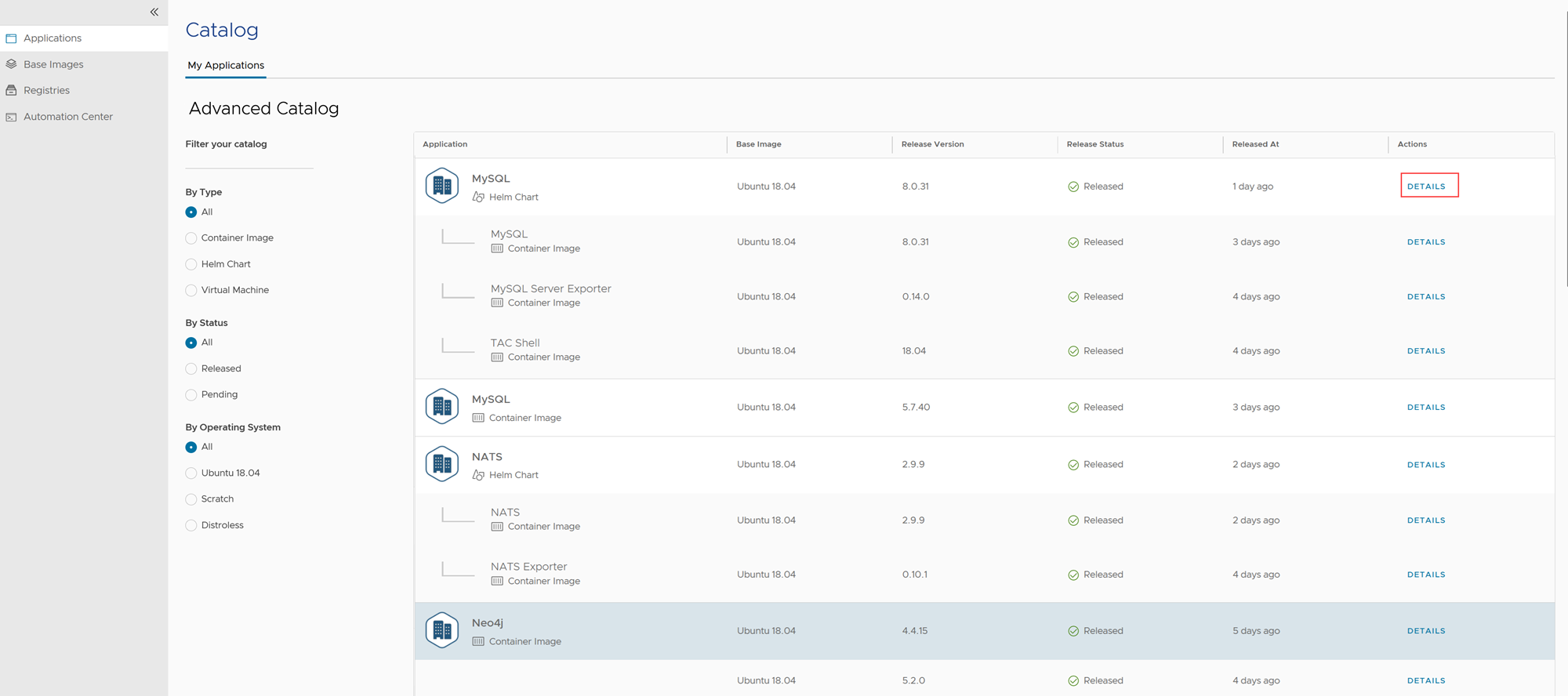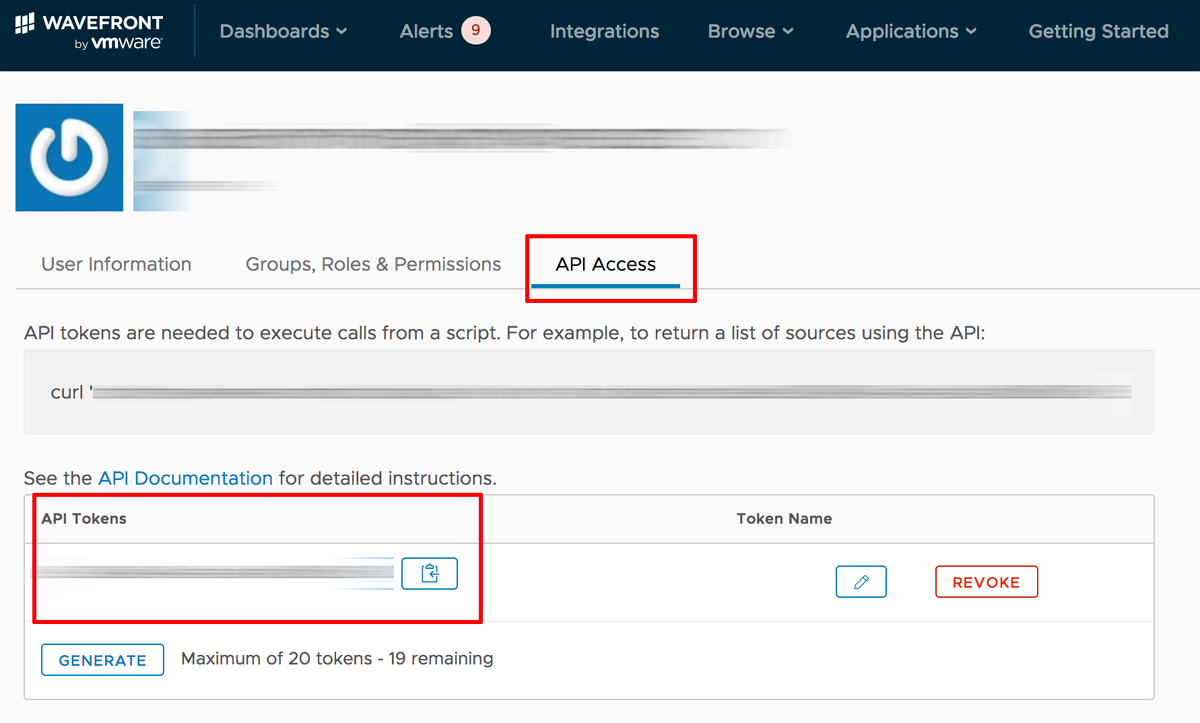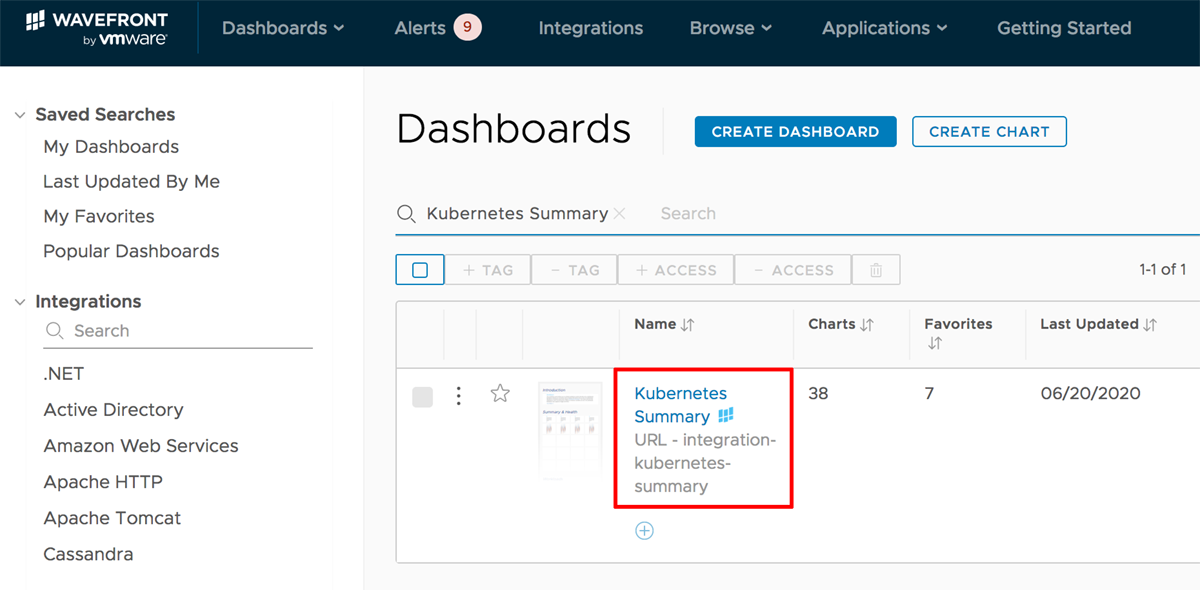Discover and monitor VMware Tanzu Application Catalog workloads with Wavefront
This section gets you started, by explaining how to discover and monitor VMware Tanzu Application Catalog (Tanzu Application Catalog) workloads on Kubernetes with Wavefront.
Wavefront by VMware by VMware is an enterprise-ready monitoring dashboard for Kubernetes that provides a unified view of cluster operations using interactive, widget-based dashboards. Some of its key features include: * Real-time visibility of operational metrics across platforms and cloud providers * Advanced alerts based on multiple metrics across different domains * Quicker root cause analysis with AI, analytics and incident data drill-down * 200+ pre-built integrations and dashboards for popular services and tools
Monitoring application workloads in a Kubernetes cluster is important for both application developers and administrators. For developers, ongoing monitoring provides insight into application performance under different scenarios and possible performance improvements. For administrators, monitoring is an effective way to track the overall health of the cluster and take proactive action to scale out the cluster as needed to ensure uptime and reliability.
Tanzu Application Catalog is a customizable selection of open source software from Bitnami that is continuously maintained and verifiably tested for use in production environments. Tanzu Application Catalog workloads on Kubernetes can also be integrated easily with Wavefront’s monitoring systems.
What to do first
Ensure:
- You have a subscription to Tanzu Application Catalog. However, the steps outlined below also hold true for fully-functional Tanzu Application Catalog environments. To subscribe, see request access contact your VMware sales representative.
- You have a Kubernetes cluster running with Helm v3.x and kubectl installed. To Learn more about getting started with Kubernetes and Helm using different cloud provider, see Kubernetes.
- You have a Wavefront account. If you don’t, see sign up, for a free trial.
This guide deploys the MySQL Helm chart from the Tanzu Application Catalog as an example and describes how to discover and monitor the deployment with Wavefront. Follow the steps as explained in the sections below and the same steps can be used with other Tanzu Application Catalog workloads as well.
Deploy MySQL
NoteIf you already have a MySQL deployment created using the Tanzu Application Catalog Helm chart, you can skip this step.
The first step is to deploy a MySQL cluster on Kubernetes using the MySQL Helm chart from the Tanzu Application Catalog. Follow these steps:
- Log in to the Tanzu Application Catalog dashboard.
- Select your organization.
-
Locate and select the Helm chart you wish to use. Click the “Details” link. In this example, select the MySQL chart.

-
Use the example commands shown on the detail page to deploy the MySQL Helm chart with 3 replica nodes. For example:
export HELM_EXPERIMENTAL_OCI=1 helm registry login my.registry.com/charts helm install oci://my.registry.com/charts/mysql --version 9.4.3 --generate-name --set root.password=PASSWORD --set replicas=3
Wait until the deployment is complete and use the kubectl get pods command to confirm that the MySQL pods are running before proceeding to the next step.
Obtain a Wavefront API token
The next step is to obtain a Wavefront API token. This token will be used by Wavefront Collector to send data from your cluster to your Wavefront instance. Follow these steps:
- Log in to Wavefront.
- Click the cogwheel icon in the top right corner.
- In the resulting drop-down menu, select your username.
- Navigate to the “API Access” tab.
- Click “Generate” to generate a new token.
-
Copy or note the token value.

Deploy Wavefront Collector
The next step is to deploy Wavefront Collector on the Kubernetes cluster. Wavefront Collector includes auto discovery, which can be configured to automatically find services running on the cluster and make data from those services available in customized Wavefront dashboards. Wavefront auto-discovery is available for most common services, including Redis, Apache, Consul, MySQL, MongoDB and many others.
The Tanzu Application Catalog includes a Helm chart that makes it quick and easy to deploy Wavefront Collector on your Kubernetes cluster. Follow the steps below to use it:
-
Create a file named values.yaml for the Wavefront Collector Helm chart with the following parameters. Replace the CLUSTER-NAME and URL placeholders with your cluster name and Wavefront instance base URL. Replace the TOKEN placeholder with the Wavefront API token obtained in Step 2, and the PASSWORD placeholder with the MySQL password set in Step 1.
clusterName: CLUSTER-NAME wavefront: url: URL token: TOKEN collector: enabled: true discovery: enabled: true config: - name: mysql type: telegraf/mysql selectors: images: - "*mysql*" - "mysql:*" collection: interval: "180s" port: 3306 conf: | servers = ["root:PASSWORD@tcp(${host}:${port})/?tls=false"] perf_events_statements_digest_text_limit = 120 perf_events_statements_limit = 250 perf_events_statements_time_limit = 86400 table_schema_databases = [] gather_process_list = true gather_table_io_waits = true gather_table_lock_waits = true gather_index_io_waits = true gather_event_waits = true gather_file_events_stats = true interval_slow = "30m"Wavefront auto-discovery uses selectors to identify pods and services. In the configuration shown above, the image selector tells Wavefront to use the Telegraf MySQL plugin for pods using an image containing the keyword mysql. You can find more examples of how to configure Wavefront auto-discovery for different services in this sample configuration file.
Tip If you wish to monitor multiple MySQL deployments, add them to the servers list as comma-separated entries.
-
Add the Tanzu Application Catalog repository to Helm, only if you did not already do so in step 1. Replace the REPOSITORY placeholder with a reference to your Tanzu Application Catalog chart repository.
$ helm repo add REPOSITORY https://MY_REGISTRY/Note
Replace the REPOSITORY and https://MY_REGISTRY/ placeholders with a reference to your Tanzu Application Catalog chart repository and the URL of your private registry where your catalog is located, respectively.
-
Deploy the Wavefront Collector Helm chart using the configuration shown previously:
$ helm install wavefront REPOSITORY/wavefront --values values.yaml
Wait until the deployment is complete and use the kubectl get pods command to confirm that the Wavefront Collector pods are running before proceeding to the next step.
Test the integration
To test the integration and visualize data from the MySQL service in Wavefront, follow these steps:
- Log in to Wavefront.
-
On the “Dashboards” page, search for the “Kubernetes Summary” dashboard and select it.

-
On the “Kubernetes Summary” dashboard, select your cluster from the drop-down list. A summary of your cluster with health and operational metrics will appear.

-
Navigate to the “Workloads” section. A summary of auto-discovered workloads will appear. In this example, you should see a MySQL workload representing the MySQL service running in the cluster.

-
Click the workload. A workload-specific dashboard will load with specific details such as the number of connections, users, databases, tables, errors and locks. This information can be further filtered by instance IP address, database name, table name and/or user name to show more granular information.

At this point, the integration is complete and verified. If you have other Tanzu Application Catalog charts deployed in the cluster, you can configure Wavefront to discover and display metrics from those services in a similar manner.